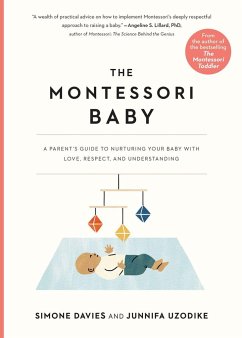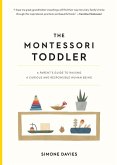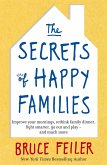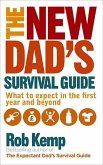Junnifa Uzodike, Simone Davies
Montessori Baby
A Parent's Guide to Nurturing Your Baby with Love, Respect, and Understanding
15,99 €
inkl. MwSt.
Sofort lieferbar

8 °P sammeln
Junnifa Uzodike, Simone Davies
Montessori Baby
A Parent's Guide to Nurturing Your Baby with Love, Respect, and Understanding
- Broschiertes Buch
- Merkliste
- Auf die Merkliste
- Bewerten Bewerten
- Teilen
- Produkt teilen
- Produkterinnerung
- Produkterinnerung
A guide to raising a baby from birth to age one by applying the wisdom of Montessori, from the bestselling author of The Montessori Toddler and a coauthor with expertise in infant care and education.
Andere Kunden interessierten sich auch für
![Montessori Toddler Montessori Toddler]() Simone DaviesMontessori Toddler12,99 €
Simone DaviesMontessori Toddler12,99 €![The Montessori Child The Montessori Child]() Junnifa UzodikeThe Montessori Child15,19 €
Junnifa UzodikeThe Montessori Child15,19 €![Raising Tiny Humans Raising Tiny Humans]() Liz SwensonRaising Tiny Humans10,99 €
Liz SwensonRaising Tiny Humans10,99 €![Baby's First Year Journal Baby's First Year Journal]() Annabel KarmelBaby's First Year Journal9,99 €
Annabel KarmelBaby's First Year Journal9,99 €![The Contented Baby with Toddler Book The Contented Baby with Toddler Book]() Contented Little Baby Gina FordThe Contented Baby with Toddler Book24,99 €
Contented Little Baby Gina FordThe Contented Baby with Toddler Book24,99 €![The Secrets of Happy Families The Secrets of Happy Families]() Bruce FeilerThe Secrets of Happy Families22,99 €
Bruce FeilerThe Secrets of Happy Families22,99 €![The New Dad's Survival Guide The New Dad's Survival Guide]() Rob KempThe New Dad's Survival Guide14,99 €
Rob KempThe New Dad's Survival Guide14,99 €-
-
-
A guide to raising a baby from birth to age one by applying the wisdom of Montessori, from the bestselling author of The Montessori Toddler and a coauthor with expertise in infant care and education.
Hinweis: Dieser Artikel kann nur an eine deutsche Lieferadresse ausgeliefert werden.
Hinweis: Dieser Artikel kann nur an eine deutsche Lieferadresse ausgeliefert werden.
Produktdetails
- Produktdetails
- The Parents' Guide to Montessori Nr.2
- Verlag: Workman Publishing
- Seitenzahl: 278
- Erscheinungstermin: April 2021
- Englisch
- Abmessung: 238mm x 171mm x 24mm
- Gewicht: 736g
- ISBN-13: 9781523512409
- ISBN-10: 1523512407
- Artikelnr.: 59764291
- Herstellerkennzeichnung
- Libri GmbH
- Europaallee 1
- 36244 Bad Hersfeld
- gpsr@libri.de
- The Parents' Guide to Montessori Nr.2
- Verlag: Workman Publishing
- Seitenzahl: 278
- Erscheinungstermin: April 2021
- Englisch
- Abmessung: 238mm x 171mm x 24mm
- Gewicht: 736g
- ISBN-13: 9781523512409
- ISBN-10: 1523512407
- Artikelnr.: 59764291
- Herstellerkennzeichnung
- Libri GmbH
- Europaallee 1
- 36244 Bad Hersfeld
- gpsr@libri.de
Simone Davies is an AMI (Association Montessori Internationale) Montessori teacher, as well as the author of The Montessori Notebook, the popular blog and Instagram where shes gives tips, answers questions, and provides online workshops to parents around the world. A native Australian, she and her family live in Amsterdam, where she runs parent-child classes at the Jacaranda Tree Montessori school. Junnifa Uzodike, an AMI-trained Montessori teacher, sits on the executive board of AMI. She runs a Montessori school, Fruitful Orchard, in Abuja, Nigeria, where she lives with her husband and three young children.
THE MONTESSORI BABY
TABLE OF CONTENTS
1 INTRODUCTION
It’s time for a change in the way we see babies
Why we love babies
What we need to know about babies
How to read this book
What babies are really telling us
2 Introduction to Montessori
What? Montessori education for babies?
A brief history of Montessori
What is Montessori?
Some important Montessori principles
- Absorbent mind
- Human tendencies
- Sensitive periods
- Observation
- Prepared environment
3 From conception to the first 6 weeks
Before the baby arrives
- Wanting for baby
- Conception to birth
The birth
Symbiosis - the first 6 to 8 weeks with our baby
The voice of the newborn: an interview with Karin Slabaugh
4 Setting up the home
Setting up Montessori-style spaces
8 tips for setting up the home
Babies do not need that much
Create “yes” spaces
Observe and rotate
Room by room
Floor bed questions
Tips for tricky situations
- Spaces where there are older siblings
- Small spaces
- Getting rid of the clutter
What’s next - preparing the home for a young toddler
Benefits of setting up our home Montessori-style
House tour
A Montessori home from the baby’s perspective by Zach
5 Montessori activities for baby
PART 1 Introduction to activities
How can we support our baby’s development
How to choose activities for our baby
Our role is to prepare the environment, not be the entertainer
How to help if our baby is stuck or struggling
PART 2 Language activities
0-3 months
3-6 months
7-9 months
9-12 months
12+ months
Bilingualism
PART 3 Movement activities
Activities to Support the Development of Movement
0-3 months
3-6 months
7-9 months
9-12 months
PART 4 Other
Music
The Outdoors
Further notes on activities for babies
- Spontaneous exploration with objects
- Dressing for movement
6 PARENTING THE MONTESSORI BABY
Trust
Acceptance
Respect
Having kind and clear boundaries
Encouraging concentration
Freedom of movement
A secure attachment
When our baby cries
Be their guide
Framing their view of the world
Foster connection with our baby
Go slow
7 PUTTING IT INTO PRACTICE
PART 1 DAILY LIFE
Daily rhythm
Eating
Sleeping
Teething
Using a pacifier
Travelling in the car
Baby wearing
Sharing
Colic & reflux
Screentime
PART 2 PHYSICAL CARE
Clothing
Diapering
Bathing the baby
PART 3 CHALLENGES IN DAILY LIFE
What to do when behaviours change? Hitting/throwing/biting/pushing
What if the baby is clingy and won’t let us put them down?
How can I stop them touching things? When will they stop putting things in
their mouth?
What to do when we are cooking or need to do errands?
How can you do Montessori on a budget?
PART 4 OTHER
Siblings
Twins
Premature babies
Adoptive parents
Physical disabilities or neurological difficulties
8 PREPARATION OF THE ADULT
Preparing ourselves
Intellectual
Physical
Emotional and spiritual
49 ideas for staying calm
Do our best
9 WORKING TOGETHER
We don’t walk alone
- It’s ok to ask for help
- Working with our partners
- Working with grandparents and carers
- Being a single parent or co-parent
Getting on the same page
What to look for in a nursery or carer
Saying goodbye to our baby
Notes for our visitors - grandparents, friends, carers
10 WHAT’S NEXT
The toddler years
The following years
- The child from 0-6 years
- The child from 6-12 years
- The child from 12-18 years
- The child from 18-24 years
The path to peace
BONUS Real stories
MONTH BY MONTH SUMMARIES
FURTHER READING
APPENDICES
Junnifa’s observations of Solu - birth to 15 weeks
Where to find materials
DIY activities
- How to make Montessori mobiles and patchwork ball
- How to make a topponcino
- DIY object permanence box
- Rings on a peg or dowel
- Rattles - to come
- Ball Tracker
Equilibrium and hand timeline
Psychomotor timeline
Primitive reflexes - to come
Montessori activities by age - 0 to 12 months
TABLE OF CONTENTS
1 INTRODUCTION
It’s time for a change in the way we see babies
Why we love babies
What we need to know about babies
How to read this book
What babies are really telling us
2 Introduction to Montessori
What? Montessori education for babies?
A brief history of Montessori
What is Montessori?
Some important Montessori principles
- Absorbent mind
- Human tendencies
- Sensitive periods
- Observation
- Prepared environment
3 From conception to the first 6 weeks
Before the baby arrives
- Wanting for baby
- Conception to birth
The birth
Symbiosis - the first 6 to 8 weeks with our baby
The voice of the newborn: an interview with Karin Slabaugh
4 Setting up the home
Setting up Montessori-style spaces
8 tips for setting up the home
Babies do not need that much
Create “yes” spaces
Observe and rotate
Room by room
Floor bed questions
Tips for tricky situations
- Spaces where there are older siblings
- Small spaces
- Getting rid of the clutter
What’s next - preparing the home for a young toddler
Benefits of setting up our home Montessori-style
House tour
A Montessori home from the baby’s perspective by Zach
5 Montessori activities for baby
PART 1 Introduction to activities
How can we support our baby’s development
How to choose activities for our baby
Our role is to prepare the environment, not be the entertainer
How to help if our baby is stuck or struggling
PART 2 Language activities
0-3 months
3-6 months
7-9 months
9-12 months
12+ months
Bilingualism
PART 3 Movement activities
Activities to Support the Development of Movement
0-3 months
3-6 months
7-9 months
9-12 months
PART 4 Other
Music
The Outdoors
Further notes on activities for babies
- Spontaneous exploration with objects
- Dressing for movement
6 PARENTING THE MONTESSORI BABY
Trust
Acceptance
Respect
Having kind and clear boundaries
Encouraging concentration
Freedom of movement
A secure attachment
When our baby cries
Be their guide
Framing their view of the world
Foster connection with our baby
Go slow
7 PUTTING IT INTO PRACTICE
PART 1 DAILY LIFE
Daily rhythm
Eating
Sleeping
Teething
Using a pacifier
Travelling in the car
Baby wearing
Sharing
Colic & reflux
Screentime
PART 2 PHYSICAL CARE
Clothing
Diapering
Bathing the baby
PART 3 CHALLENGES IN DAILY LIFE
What to do when behaviours change? Hitting/throwing/biting/pushing
What if the baby is clingy and won’t let us put them down?
How can I stop them touching things? When will they stop putting things in
their mouth?
What to do when we are cooking or need to do errands?
How can you do Montessori on a budget?
PART 4 OTHER
Siblings
Twins
Premature babies
Adoptive parents
Physical disabilities or neurological difficulties
8 PREPARATION OF THE ADULT
Preparing ourselves
Intellectual
Physical
Emotional and spiritual
49 ideas for staying calm
Do our best
9 WORKING TOGETHER
We don’t walk alone
- It’s ok to ask for help
- Working with our partners
- Working with grandparents and carers
- Being a single parent or co-parent
Getting on the same page
What to look for in a nursery or carer
Saying goodbye to our baby
Notes for our visitors - grandparents, friends, carers
10 WHAT’S NEXT
The toddler years
The following years
- The child from 0-6 years
- The child from 6-12 years
- The child from 12-18 years
- The child from 18-24 years
The path to peace
BONUS Real stories
MONTH BY MONTH SUMMARIES
FURTHER READING
APPENDICES
Junnifa’s observations of Solu - birth to 15 weeks
Where to find materials
DIY activities
- How to make Montessori mobiles and patchwork ball
- How to make a topponcino
- DIY object permanence box
- Rings on a peg or dowel
- Rattles - to come
- Ball Tracker
Equilibrium and hand timeline
Psychomotor timeline
Primitive reflexes - to come
Montessori activities by age - 0 to 12 months
THE MONTESSORI BABY
TABLE OF CONTENTS
1 INTRODUCTION
It’s time for a change in the way we see babies
Why we love babies
What we need to know about babies
How to read this book
What babies are really telling us
2 Introduction to Montessori
What? Montessori education for babies?
A brief history of Montessori
What is Montessori?
Some important Montessori principles
- Absorbent mind
- Human tendencies
- Sensitive periods
- Observation
- Prepared environment
3 From conception to the first 6 weeks
Before the baby arrives
- Wanting for baby
- Conception to birth
The birth
Symbiosis - the first 6 to 8 weeks with our baby
The voice of the newborn: an interview with Karin Slabaugh
4 Setting up the home
Setting up Montessori-style spaces
8 tips for setting up the home
Babies do not need that much
Create “yes” spaces
Observe and rotate
Room by room
Floor bed questions
Tips for tricky situations
- Spaces where there are older siblings
- Small spaces
- Getting rid of the clutter
What’s next - preparing the home for a young toddler
Benefits of setting up our home Montessori-style
House tour
A Montessori home from the baby’s perspective by Zach
5 Montessori activities for baby
PART 1 Introduction to activities
How can we support our baby’s development
How to choose activities for our baby
Our role is to prepare the environment, not be the entertainer
How to help if our baby is stuck or struggling
PART 2 Language activities
0-3 months
3-6 months
7-9 months
9-12 months
12+ months
Bilingualism
PART 3 Movement activities
Activities to Support the Development of Movement
0-3 months
3-6 months
7-9 months
9-12 months
PART 4 Other
Music
The Outdoors
Further notes on activities for babies
- Spontaneous exploration with objects
- Dressing for movement
6 PARENTING THE MONTESSORI BABY
Trust
Acceptance
Respect
Having kind and clear boundaries
Encouraging concentration
Freedom of movement
A secure attachment
When our baby cries
Be their guide
Framing their view of the world
Foster connection with our baby
Go slow
7 PUTTING IT INTO PRACTICE
PART 1 DAILY LIFE
Daily rhythm
Eating
Sleeping
Teething
Using a pacifier
Travelling in the car
Baby wearing
Sharing
Colic & reflux
Screentime
PART 2 PHYSICAL CARE
Clothing
Diapering
Bathing the baby
PART 3 CHALLENGES IN DAILY LIFE
What to do when behaviours change? Hitting/throwing/biting/pushing
What if the baby is clingy and won’t let us put them down?
How can I stop them touching things? When will they stop putting things in
their mouth?
What to do when we are cooking or need to do errands?
How can you do Montessori on a budget?
PART 4 OTHER
Siblings
Twins
Premature babies
Adoptive parents
Physical disabilities or neurological difficulties
8 PREPARATION OF THE ADULT
Preparing ourselves
Intellectual
Physical
Emotional and spiritual
49 ideas for staying calm
Do our best
9 WORKING TOGETHER
We don’t walk alone
- It’s ok to ask for help
- Working with our partners
- Working with grandparents and carers
- Being a single parent or co-parent
Getting on the same page
What to look for in a nursery or carer
Saying goodbye to our baby
Notes for our visitors - grandparents, friends, carers
10 WHAT’S NEXT
The toddler years
The following years
- The child from 0-6 years
- The child from 6-12 years
- The child from 12-18 years
- The child from 18-24 years
The path to peace
BONUS Real stories
MONTH BY MONTH SUMMARIES
FURTHER READING
APPENDICES
Junnifa’s observations of Solu - birth to 15 weeks
Where to find materials
DIY activities
- How to make Montessori mobiles and patchwork ball
- How to make a topponcino
- DIY object permanence box
- Rings on a peg or dowel
- Rattles - to come
- Ball Tracker
Equilibrium and hand timeline
Psychomotor timeline
Primitive reflexes - to come
Montessori activities by age - 0 to 12 months
TABLE OF CONTENTS
1 INTRODUCTION
It’s time for a change in the way we see babies
Why we love babies
What we need to know about babies
How to read this book
What babies are really telling us
2 Introduction to Montessori
What? Montessori education for babies?
A brief history of Montessori
What is Montessori?
Some important Montessori principles
- Absorbent mind
- Human tendencies
- Sensitive periods
- Observation
- Prepared environment
3 From conception to the first 6 weeks
Before the baby arrives
- Wanting for baby
- Conception to birth
The birth
Symbiosis - the first 6 to 8 weeks with our baby
The voice of the newborn: an interview with Karin Slabaugh
4 Setting up the home
Setting up Montessori-style spaces
8 tips for setting up the home
Babies do not need that much
Create “yes” spaces
Observe and rotate
Room by room
Floor bed questions
Tips for tricky situations
- Spaces where there are older siblings
- Small spaces
- Getting rid of the clutter
What’s next - preparing the home for a young toddler
Benefits of setting up our home Montessori-style
House tour
A Montessori home from the baby’s perspective by Zach
5 Montessori activities for baby
PART 1 Introduction to activities
How can we support our baby’s development
How to choose activities for our baby
Our role is to prepare the environment, not be the entertainer
How to help if our baby is stuck or struggling
PART 2 Language activities
0-3 months
3-6 months
7-9 months
9-12 months
12+ months
Bilingualism
PART 3 Movement activities
Activities to Support the Development of Movement
0-3 months
3-6 months
7-9 months
9-12 months
PART 4 Other
Music
The Outdoors
Further notes on activities for babies
- Spontaneous exploration with objects
- Dressing for movement
6 PARENTING THE MONTESSORI BABY
Trust
Acceptance
Respect
Having kind and clear boundaries
Encouraging concentration
Freedom of movement
A secure attachment
When our baby cries
Be their guide
Framing their view of the world
Foster connection with our baby
Go slow
7 PUTTING IT INTO PRACTICE
PART 1 DAILY LIFE
Daily rhythm
Eating
Sleeping
Teething
Using a pacifier
Travelling in the car
Baby wearing
Sharing
Colic & reflux
Screentime
PART 2 PHYSICAL CARE
Clothing
Diapering
Bathing the baby
PART 3 CHALLENGES IN DAILY LIFE
What to do when behaviours change? Hitting/throwing/biting/pushing
What if the baby is clingy and won’t let us put them down?
How can I stop them touching things? When will they stop putting things in
their mouth?
What to do when we are cooking or need to do errands?
How can you do Montessori on a budget?
PART 4 OTHER
Siblings
Twins
Premature babies
Adoptive parents
Physical disabilities or neurological difficulties
8 PREPARATION OF THE ADULT
Preparing ourselves
Intellectual
Physical
Emotional and spiritual
49 ideas for staying calm
Do our best
9 WORKING TOGETHER
We don’t walk alone
- It’s ok to ask for help
- Working with our partners
- Working with grandparents and carers
- Being a single parent or co-parent
Getting on the same page
What to look for in a nursery or carer
Saying goodbye to our baby
Notes for our visitors - grandparents, friends, carers
10 WHAT’S NEXT
The toddler years
The following years
- The child from 0-6 years
- The child from 6-12 years
- The child from 12-18 years
- The child from 18-24 years
The path to peace
BONUS Real stories
MONTH BY MONTH SUMMARIES
FURTHER READING
APPENDICES
Junnifa’s observations of Solu - birth to 15 weeks
Where to find materials
DIY activities
- How to make Montessori mobiles and patchwork ball
- How to make a topponcino
- DIY object permanence box
- Rings on a peg or dowel
- Rattles - to come
- Ball Tracker
Equilibrium and hand timeline
Psychomotor timeline
Primitive reflexes - to come
Montessori activities by age - 0 to 12 months







